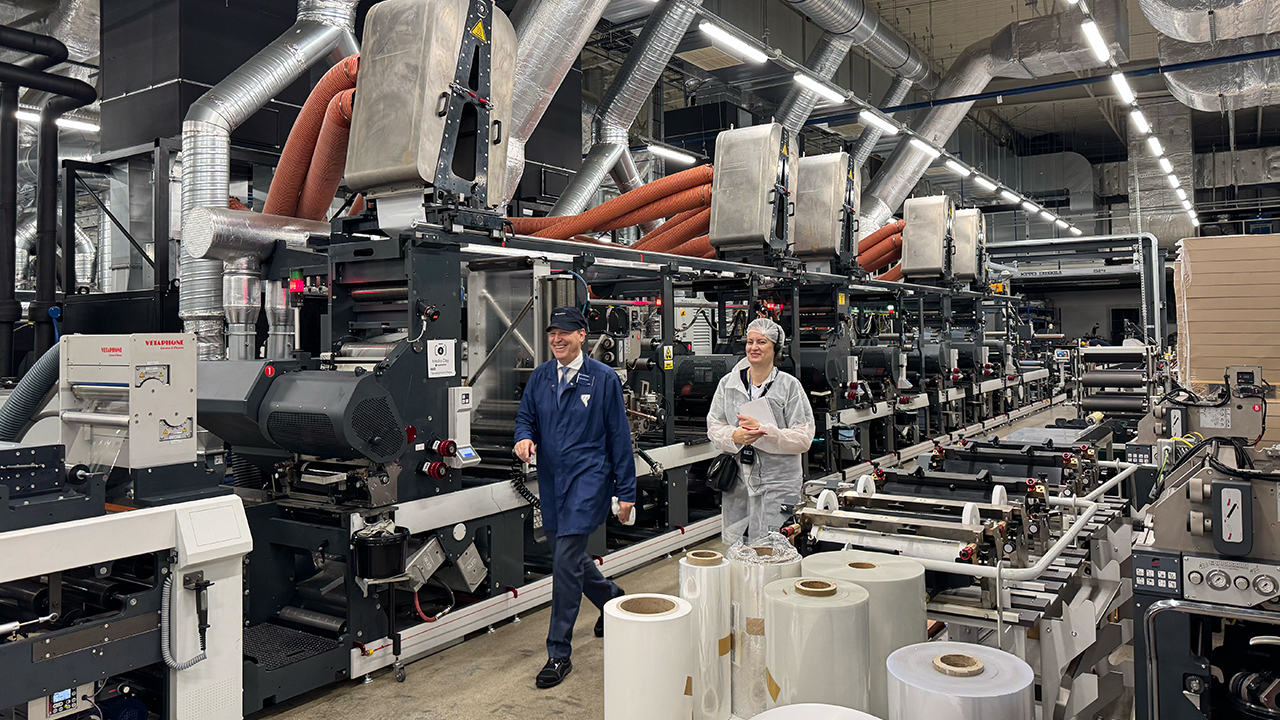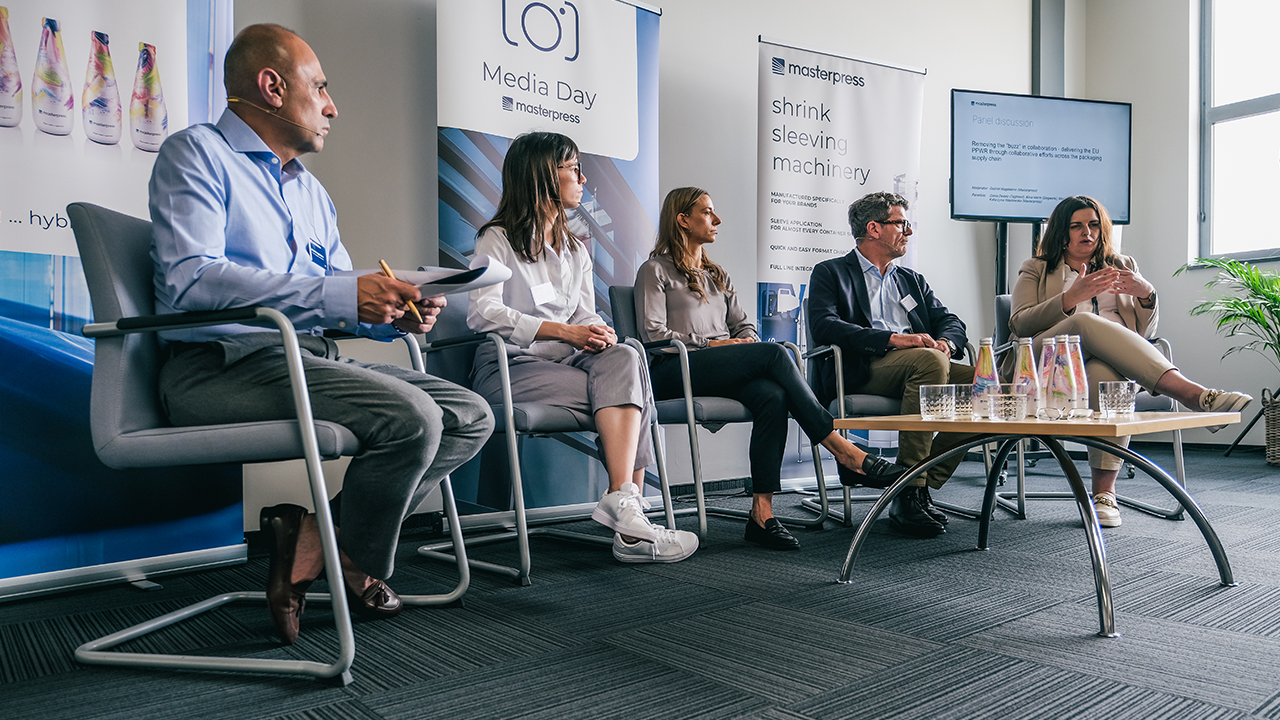Masterpress makes its mark
More than 20 years after first visiting Masterpress in Poland, Andy Thomas-Emans returns to see a new factory and a transformed company pushing the boundaries of sustainable label production

Masterpress SA is today one of Europe’s leading privately owned label converting companies, doubling its turnover to 50m EUR (57m USD) over the last 10 years and pursuing a relentless focus on innovation and sustainability.
Since 1998, Masterpress has invested over 70m EUR (approximately 80m USD) in capital machinery and plant, and is currently preparing for its next phase of expansion, moving into a new production hall next to its existing 12,000 sqm production facility in Białystok, Poland.
Origins
The origins of Masterpress are closely tied to the demise of the Soviet Union at the end of the 1980s. Waldemar Zdrodowski had moved to the US in 1988 to pursue his studies, returning to post-independence Poland in 1992. As Poland underwent a crash course in capitalist development, Zdrodowski and university friend Miroslaw Zywicki saw an opportunity in commercial print. They set up a new company using sheet-fed offset equipment. This was registered as Masterpress SA in 1996.
Spotting an increasing demand for self-adhesive rolls in the dairy and other food sectors, in 1998, Masterpress installed its first narrow web presses, two water-based 10in Propheteers. With the PSL business growing rapidly, Masterpress began a long partnership with Gidue in 2002, installing a total of seven 370mm-wide Combat UV flexo presses.
By 2004, shrink sleeves were experiencing rapid growth in Poland. Masterpress installed a 630mm-wide Gidue Athena and made its first move into shrink sleeve labels.
Three years later, Masterpress embarked on a new partnership with Omet, installing a 10-color 670mm Varyflex with a reversible rotogravure unit for laying down a first white, metallic or overvarnish. Masterpress went on to install six Omet presses, each uniquely tailored to the company’s evolving requirements. This fleet included two Varyflex lines, two 10-color XFlex 430mm lines, and two hybrid offset XFlex X6 presses, 430mm and 670mm wide.
Shrink sleeve specialist
Today, shrink sleeve labels account for some 70 percent of Masterpress’ output, with self-adhesive labels accounting for around 25 percent. Masterpress also manufactures a full range of shrink sleeve machinery, including applicators, hot steam shrink tunnels, air-knife dryers and robotics handling equipment. Additional options include perforation modules, label positioning devices and duopack modules.
Masterpress sells these machinery systems to its sleeve label customers, along with servicing and training, and also offers an in-house sleeve application service for customers who do not want to invest themselves.
Gabriel Magdaleno, strategic product management and marketing director at Masterpress, points out the advantages of controlling the entire shrink sleeve process from design through printing, converting and application.
‘We can be confident that what we print will run on our own shrink tunnels. That is the advantage of controlling the whole process from design to application, including artwork distortion and materials. This is particularly important when we are dealing with complex-shaped containers.’
Masterpress utilizes Esko workstations for 3D conceptualization of sleeve designs and distortion of flat artwork. The Esko Automation Engine drives all prepress workflows at Masterpress.
In 2023, Masterpress added 16 million sqm of capacity with two new presses dedicated to shrink sleeve printing, expanding the company’s production capacity by nearly 40 percent. The two 12- and 14-station presses can handle a variety of materials and varnishes in the same pass, enabling UV flexo printing, embossing and Braille, as well as web perforation. The presses are LED-UV equipped and can print on films down to 12 microns.
Sustainability focus
Sustainability is at the core of Masterpress’s strategy. The company collaborates closely with a range of supply chain partners to bring sustainable innovations to market in the shortest possible time.
In April 2024, Masterpress became a member of the Polish Committee for Standardization (PKN), part of the 34-country European Committee for Standardization (CEN), putting the company at the heart of developing guidelines for design for recycling as PPWR looms on the horizon.
Masterpress recently renewed its EcoVadis Silver certification, which covers reduction of overall environmental footprint, ethical labor and business practices and prioritizing sustainable procurement. Masterpress scored among the top 8 percent of companies rated by EcoVadis.
Masterpress works with its supplier partners to test and trial new sustainable ink and material technologies before they enter the commercial market. Explains Katarzyna Wasilewska, research and development manager at Masterpress, ‘We are dedicated to advancing innovation within the shrink sleeve and self-adhesive label industry and are well positioned to help accelerate the commercialization of new, sustainable, recyclable products and materials.’
Wasilewska explains how Masterpress carried out field tests of Cirkit Clearprime, printing on PE85 PS labelstock and adding bleed-resistant UV flexo inks and a UV flexo OPV.
Masterpress tested Ink removal in accordance with the QT 507 washing protocol of the European PET Bottle Platform (EPBP). The primer layer was found to dissolve residue-free in the hot washing process, while the non-bleeding ink formulations ensured a clean and reusable washing solution.
‘Our tests confirmed an impressive recyclability of the UV-printed PE labels,’ says Wasilewska. ‘Compared to other labels with no deinking technology, we could observe that contaminations of plastic recyclates due to discoloration could be massively reduced by using Siegwerk’s UV deinking primer.’
Masterpress has also worked closely with materials supplier Taghleef on multiple sustainability projects. One example is a 300g shrink-sleeved cup produced for TINE dairy products by SuperFos Lidkoeping.
Masterpress used a Taghleef LDPE (low-density polyolefin) shrink sleeve to create a mono-material pack that can be easily identified and recycled in the correct polymer stream.
“Masterpress worked closely on the development and testing of Siegwerk’s first UV flexo deinking primer, launched onto the European market in June 2024”
An additional aspect was downgauging. The sleeve material was originally a 50-micron polyolefin, but through close collaboration with Berry Superfos and Taghleef, this was successfully downgauged to 42 microns. At the time of commercializing this project, it was the thinnest PO sleeve project on the market. The cups also highlight Masterpress’ expertise in selecting low-migration inks, varnishes and adhesives.
This project, carried out in accordance with RecyClass design-for-recycling guidelines, won an AWA sleeve award.
Masterpress has also run trials on shrink films incorporating over 50 percent post-consumer waste (PCR). ‘There is no doubt that PCR is more difficult to work with, and they are currently an additional cost, which could be a barrier to wider adoption,’ says Kasia Wasilewska.
R&D press
One reason Masterpress is such an excellent testbed for new materials and inks is its dedicated R&D press and extensive laboratory testing facilities.
In December 2023, Masterpress invested heavily in the R&D lab adjacent to its manufacturing operation and dedicated a bespoke Omet Varyflex press exclusively to R&D.
The Varyflex is configured with gravure, screen, flexo, with four extended dryers for water-based inks and coatings, lamination and die-cutting.
When Labels & Labeling visited, the R&D press was running conductive ink trials to print RFID antenna on shrink sleeves and paper substrates. ‘This will allow us to print an antenna shape which is optimized for individual applications,’ says Kasia Wasilewska.
The hybrid configuration of the R&D press is typical of the other press lines installed by Masterpress, allowing the company to make full use of multi-process in-line printing techniques combining flexo, offset, rotogravure, digital and screen.
The next press investment at Masterpress will be a Mark Andy Performance Series dedicated to growing the company’s pressure-sensitive label business.
To support its flexo press fleet, Masterpress has its own in-house repro department using an Esko CDI Crystal 4835 platemaking system and Evo plate processor with in-line drying.
Conclusion
Masterpress has been on an amazing journey since this writer first visited the company two decades ago. The converter maintains an impressive focus on practical innovation, driving forward the development of new sustainable materials, inks and smart label processes in close collaboration with partners up and down the supply chain. And behind this remains the remarkable Waldemar Zdrodowski, still very much engaged as the driving force behind Masterpress.
Sustainability panel discussion

An extremely interesting panel discussion on the implications of the EU’s PPWR directive brought together expert speakers from Masterpress, Siegwerk and Taghleef.
The panellists agreed that PPWR’s circular economy ambitions conflict with cost factors, with recycled content remaining more expensive than virgin materials. Consumers cannot be expected to solve this dilemma by paying more for recycled/recyclable products, particularly in developing countries.
Another potential conflict is between rapidly expanding use of PCR materials and food contact regulations, as well as PCR chain of custody to guarantee consistent quality.
Other uncertainties include incompatible recycling infrastructures and how deposit schemes and the digital product passport (DPP) will be implemented.
The panel agreed these challenges are best met by designing for recycling now, despite the PPWR guidelines not being available until 2028.
Marc Larvor, head of technology for narrow web at Siegwerk, said that PPWR at least guarantees a market for sustainable packaging by 2030.
‘We may not know exactly what it looks like, but
investment is a safe space, so we can push the transformation of our portfolios,’ Larvor said. ‘If we start the work in 2028, it is already too late.’
On a positive note, the panelists noted how the German Ink Ordinance, with its ‘aggressive’ deadlines, has shown how supply chain collaboration can work effectively. Larvor explained how Siegwerk had prototyped its GIO inks with Masterpress. ‘GIO was a threat three years ago, and now it is an opportunity.’
Stay up to date
Subscribe to the free Label News newsletter and receive the latest content every week. We'll never share your email address.


